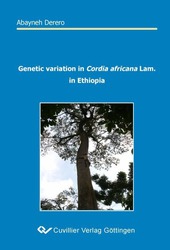| Departments | |
|---|---|
| Book Series (96) |
1378
|
| Nachhaltigkeit |
3
|
| Gesundheitswesen |
1
|
| Humanities |
2363
|
| Natural Sciences |
5406
|
| Mathematics | 229 |
| Informatics | 319 |
| Physics | 980 |
| Chemistry | 1363 |
| Geosciences | 131 |
| Human medicine | 243 |
| Stomatology | 10 |
| Veterinary medicine | 108 |
| Pharmacy | 147 |
| Biology | 835 |
| Biochemistry, molecular biology, gene technology | 121 |
| Biophysics | 25 |
| Domestic and nutritional science | 45 |
| Agricultural science | 1004 |
| Forest science | 201 |
| Horticultural science | 20 |
| Environmental research, ecology and landscape conservation | 148 |
| Engineering |
1791
|
| Common |
97
|
|
Leitlinien Unfallchirurgie
5. Auflage bestellen |
|
Advanced Search
Genetic variation in Cordia africana Lam. in Ethiopia (English shop)
Abayneh Derero (Author)Preview
Table of Contents, Datei (38 KB)
Extract, Datei (190 KB)
Biodiversity is an issue of global concern. It is organized in ecosystems, species and genetic diversity within species. Among the various elements of biodiversity, forests represent the biologically most diverse terrestrial ecosystems. However, deforestation poses one of the greatest risks to the maintenance and preservation of biodiversity. Especially deforestation in the tropics is alarming, and it seems hardly achievable to halt it in the near future. It is of utmost urgency that countries should embark on both in-situ and ex-situ conservation activities. Such efforts need primarily to be based on characterizing and understanding the genetic organization of the target species. One of the species that deserves attention in Ethiopia is the broadleaved tropical tree, Cordia africana Lam. (Boraginaceae). The present dissertation aims at determining the genetic variation within and among populations of C. africana in Ethiopia. The variation in the DNA of C. africana was assessed employing two marker systems; namely, amplified fragment length polymorphisms (AFLPs) and chloroplast microsatellites (cpSSR). AFLPs represent DNA markers that are randomly distributed across the genome and are generally considered as dominant markers. The chloroplast genome is a non-recombining genome and is generally inherited maternally in angiosperms. The analysis of chloroplast microsatellites in C. africana was presumed to detect genetic structures reflecting efficient gene flow via seeds, as the fruits of the species are indehiscent and edible. The populations were sampled from various geographical locations and altitudinal gradients covering the total distribution range of the species. Furthermore, the populations represented scattered (mainly trees from traditional agroforestry systems) and continuous forest conditions, various regions of provenance (seed zones), natural ecosystems and different levels of fragmentation. The populations can be categorized as belonging to the northern highlands (NHL), the south-west highlands (SWHL), the south-west lowlands (SWLL) or the south-east highlands (SEHL). Genetic variation was assessed in each population. It is assumed that different evolutionary forces (mating system, genetic drift, selection and mutation) acting on each of those populations in varying intensities shape their genetic variation patterns.
| ISBN-13 (Printausgabe) | 3867274266 |
| ISBN-13 (Hard Copy) | 9783867274265 |
| ISBN-13 (eBook) | 9783736924260 |
| Final Book Format | A5 |
| Language | English |
| Page Number | 118 |
| Edition | 1 |
| Volume | 0 |
| Publication Place | Göttingen |
| Place of Dissertation | Göttingen |
| Publication Date | 2007-11-23 |
| General Categorization | Dissertation |
| Departments |
Forest science
|
| Keywords | Genetic variation, AFLP, cpSSR, cordia africana. |








